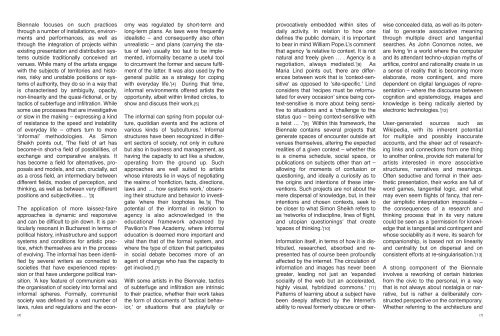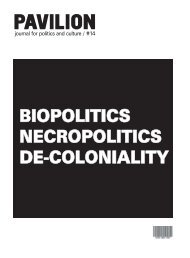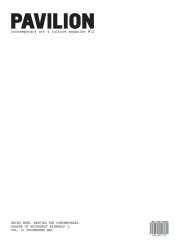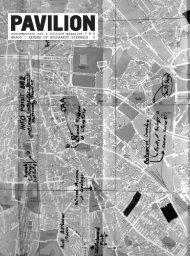Download pdf version of issue no. 16 (4 Mb) - Pavilion
Download pdf version of issue no. 16 (4 Mb) - Pavilion
Download pdf version of issue no. 16 (4 Mb) - Pavilion
Create successful ePaper yourself
Turn your PDF publications into a flip-book with our unique Google optimized e-Paper software.
Biennale focuses on such practices<br />
through a number <strong>of</strong> installations, environments<br />
and performances, as well as<br />
through the integration <strong>of</strong> projects within<br />
existing presentation and distribution systems<br />
outside traditionally conceived art<br />
venues. While many <strong>of</strong> the artists engage<br />
with the subjects <strong>of</strong> territories and histories,<br />
risky and unstable positions or systems<br />
<strong>of</strong> authority, they do so in a way that<br />
is characterised by ambiguity, opacity,<br />
<strong>no</strong>n-linearity and the quasi-fictional, or by<br />
tactics <strong>of</strong> subterfuge and infiltration. While<br />
some use processes that are investigative<br />
or slow in the making – expressing a kind<br />
<strong>of</strong> resistance to the speed and instability<br />
<strong>of</strong> everyday life – others turn to more<br />
‘informal’ methodologies. As Simon<br />
Sheikh points out, 'The field <strong>of</strong> art has<br />
become-in short-a field <strong>of</strong> possibilities, <strong>of</strong><br />
exchange and comparative analysis. It<br />
has become a field for alternatives, proposals<br />
and models, and can, crucially, act<br />
as a cross field, an intermediary between<br />
different fields, modes <strong>of</strong> perception, and<br />
thinking, as well as between very different<br />
positions and subjectivities… '[3]<br />
The application <strong>of</strong> more laissez-faire<br />
approaches is dynamic and responsive<br />
and can be difficult to pin down. It is particularly<br />
resonant in Bucharest in terms <strong>of</strong><br />
political history, infrastructure and support<br />
systems and conditions for artistic practice,<br />
which themselves are in the process<br />
<strong>of</strong> evolving. The informal has been identified<br />
by several writers as connected to<br />
societies that have experienced repression<br />
or that have undergone political transition.<br />
'A key feature <strong>of</strong> communism was<br />
the organisation <strong>of</strong> society into formal and<br />
informal spheres. Formally, communist<br />
society was defined by a vast number <strong>of</strong><br />
laws, rules and regulations and the econ-<br />
[6]<br />
omy was regulated by short-term and<br />
long-term plans. As laws were frequently<br />
idealistic – and consequently also <strong>of</strong>ten<br />
unrealistic – and plans (carrying the status<br />
<strong>of</strong> law) usually too taut to be implemented,<br />
informality became a useful tool<br />
to circumvent the former and secure fulfilment<br />
<strong>of</strong> the latter. It was also used by the<br />
general public as a strategy for coping<br />
with everyday life.'[4] During that time,<br />
informal environments <strong>of</strong>fered artists the<br />
opportunity, albeit within limited circles, to<br />
show and discuss their work.[5 ]<br />
The informal can spring from popular culture,<br />
quotidian events and the actions <strong>of</strong><br />
various kinds <strong>of</strong> 'subcultures.' Informal<br />
structures have been recognized in different<br />
sectors <strong>of</strong> society, <strong>no</strong>t only in culture<br />
but also in business and management, as<br />
having the capacity to act like a shadow,<br />
operating from the ground up. Such<br />
approaches are well suited to artists<br />
whose interests lie in ways <strong>of</strong> negotiating<br />
the realms <strong>of</strong> '<strong>no</strong>nfiction, facts, directions,<br />
laws and … how systems work,' observing<br />
their structure and behavior to investigate<br />
'where their loopholes lie.'[6] The<br />
potential <strong>of</strong> the informal in relation to<br />
agency is also ack<strong>no</strong>wledged in the<br />
educational framework advanced by<br />
<strong>Pavilion</strong>’s Free Academy, where informal<br />
education is deemed more important and<br />
vital than that <strong>of</strong> the formal system, and<br />
where the type <strong>of</strong> citizen that participates<br />
in social debate becomes more <strong>of</strong> an<br />
agent <strong>of</strong> change who has the capacity to<br />
get involved.[7]<br />
With some artists in the Biennale, tactics<br />
<strong>of</strong> subterfuge and infiltration are intrinsic<br />
to their practice, whether their work takes<br />
the form <strong>of</strong> documents <strong>of</strong> ‘tactical behavior,’<br />
or situations that are playfully or<br />
provocatively embedded within sites <strong>of</strong><br />
daily activity. In relation to how one<br />
defines the public domain, it is important<br />
to bear in mind William Pope.L’s comment<br />
that agency 'is relative to context. It is <strong>no</strong>t<br />
natural and freely given … . Agency is a<br />
negotiation, always mediated.'[8] As<br />
Maria Lind points out, there are differences<br />
between work that is 'context-sensitive'<br />
as opposed to 'site-specific.' Lind<br />
considers that 'recipes must be reformulated<br />
for every occasion' since being context-sensitive<br />
is more about being sensitive<br />
to situations and a 'challenge to the<br />
status quo – being context-sensitive with<br />
a twist … .”[9] Within this framework, the<br />
Biennale contains several projects that<br />
generate spaces <strong>of</strong> encounter outside art<br />
venues themselves, altering the expected<br />
realities <strong>of</strong> a given context – whether this<br />
is a cinema schedule, social space, or<br />
publications on subjects other than art –<br />
allowing for moments <strong>of</strong> confusion or<br />
questioning, and ideally a curiosity as to<br />
the origins and intentions <strong>of</strong> these interventions.<br />
Such projects are <strong>no</strong>t about the<br />
mere dispersal <strong>of</strong> k<strong>no</strong>wledge, but, in their<br />
intentions and chosen contexts, seek to<br />
be closer to what Simon Sheikh refers to<br />
as 'networks <strong>of</strong> indiscipline, lines <strong>of</strong> flight,<br />
and utopian questionings' that create<br />
'spaces <strong>of</strong> thinking.'[10]<br />
Information itself, in terms <strong>of</strong> how it is distributed,<br />
researched, absorbed and represented<br />
has <strong>of</strong> course been pr<strong>of</strong>oundly<br />
affected by the internet. The circulation <strong>of</strong><br />
information and images has never been<br />
greater, leading <strong>no</strong>t just an 'expanded<br />
sociality <strong>of</strong> the web but an accelerated,<br />
highly visual, hybridized commons.' [11]<br />
Patterns <strong>of</strong> learning about a subject have<br />
been deeply affected by the Internet’s<br />
ability to reveal formerly obscure or other-<br />
wise concealed data, as well as its potential<br />
to generate associative meaning<br />
through multiple direct and tangential<br />
searches. As John Co<strong>no</strong>mos <strong>no</strong>tes, we<br />
are living 'in a world where the computer<br />
and its attendant tech<strong>no</strong>-utopian myths <strong>of</strong><br />
artifice, control and rationality create in us<br />
a sense <strong>of</strong> reality that is becoming more<br />
elaborate, more contingent, and more<br />
dependent on digital languages <strong>of</strong> representation<br />
– where the discourse between<br />
cognition and epistemology, images and<br />
k<strong>no</strong>wledge is being radically alerted by<br />
electronic tech<strong>no</strong>logies.'[12]<br />
User-generated sources such as<br />
Wikipedia, with its inherent potential<br />
for multiple and possibly inaccurate<br />
accounts, and the sheer act <strong>of</strong> researching<br />
links and connections from one thing<br />
to a<strong>no</strong>ther online, provide rich material for<br />
artists interested in more associative<br />
structures, narratives and meanings.<br />
Often seductive and formal in their aesthetic<br />
presentation, their works are full <strong>of</strong><br />
word games, tangential logic, and what<br />
may even seem flights <strong>of</strong> fancy, that render<br />
simplistic interpretation impossible –<br />
the consequences <strong>of</strong> a research and<br />
thinking process that in its very nature<br />
could be seen as a 'permission for k<strong>no</strong>wledge<br />
that is tangential and contingent and<br />
whose sociability as it were, its search for<br />
companionship, is based <strong>no</strong>t on linearity<br />
and centrality but on dispersal and on<br />
consistent efforts at re-singularisation.'[13]<br />
A strong component <strong>of</strong> the Biennale<br />
involves a reworking <strong>of</strong> certain histories<br />
from the civic to the personal, in a way<br />
that is <strong>no</strong>t always about <strong>no</strong>stalgia or narrative,<br />
but is rather a deliberately constructed<br />
perspective on the contemporary.<br />
Whether referring to the architecture and<br />
[7]








